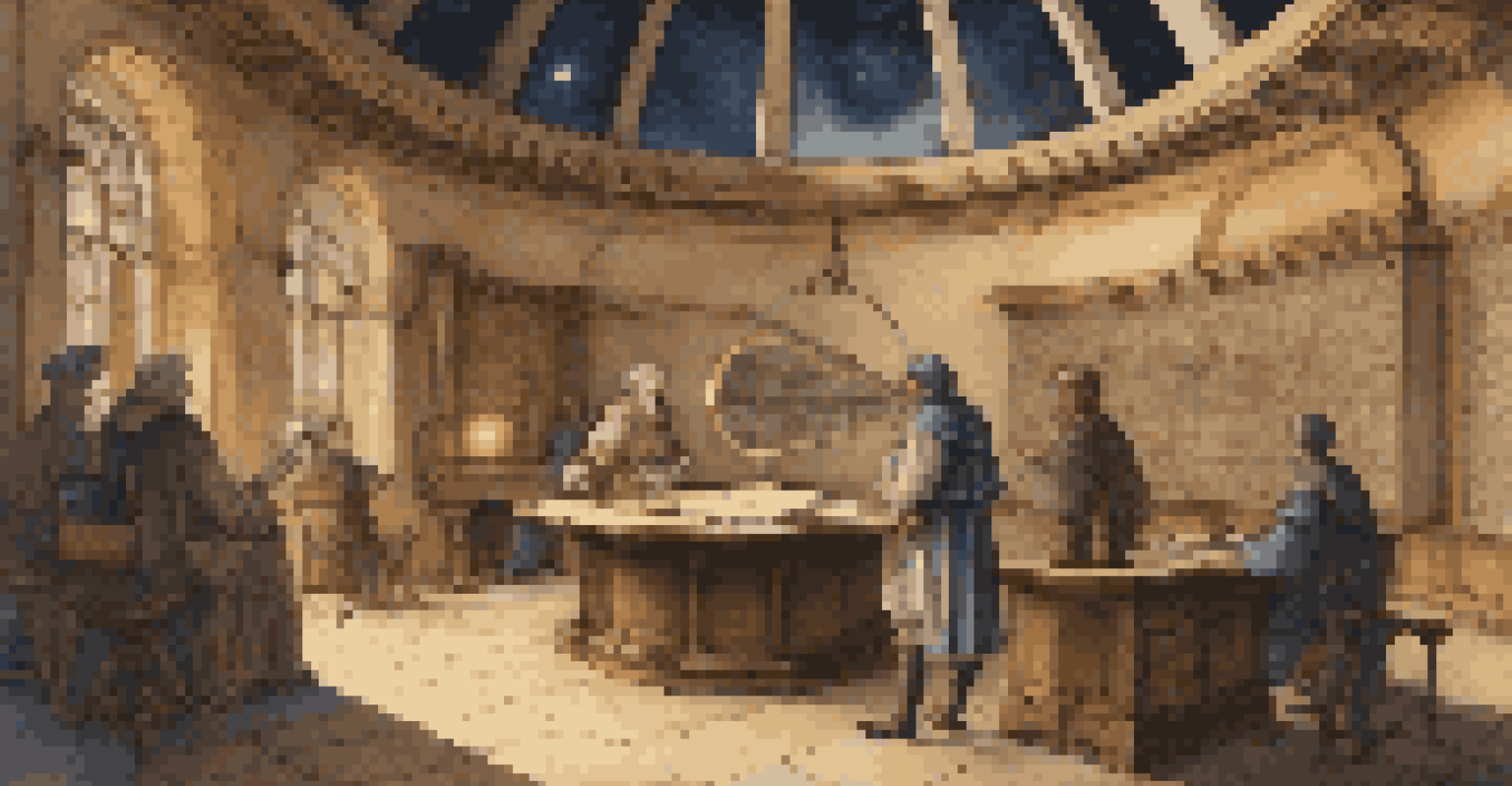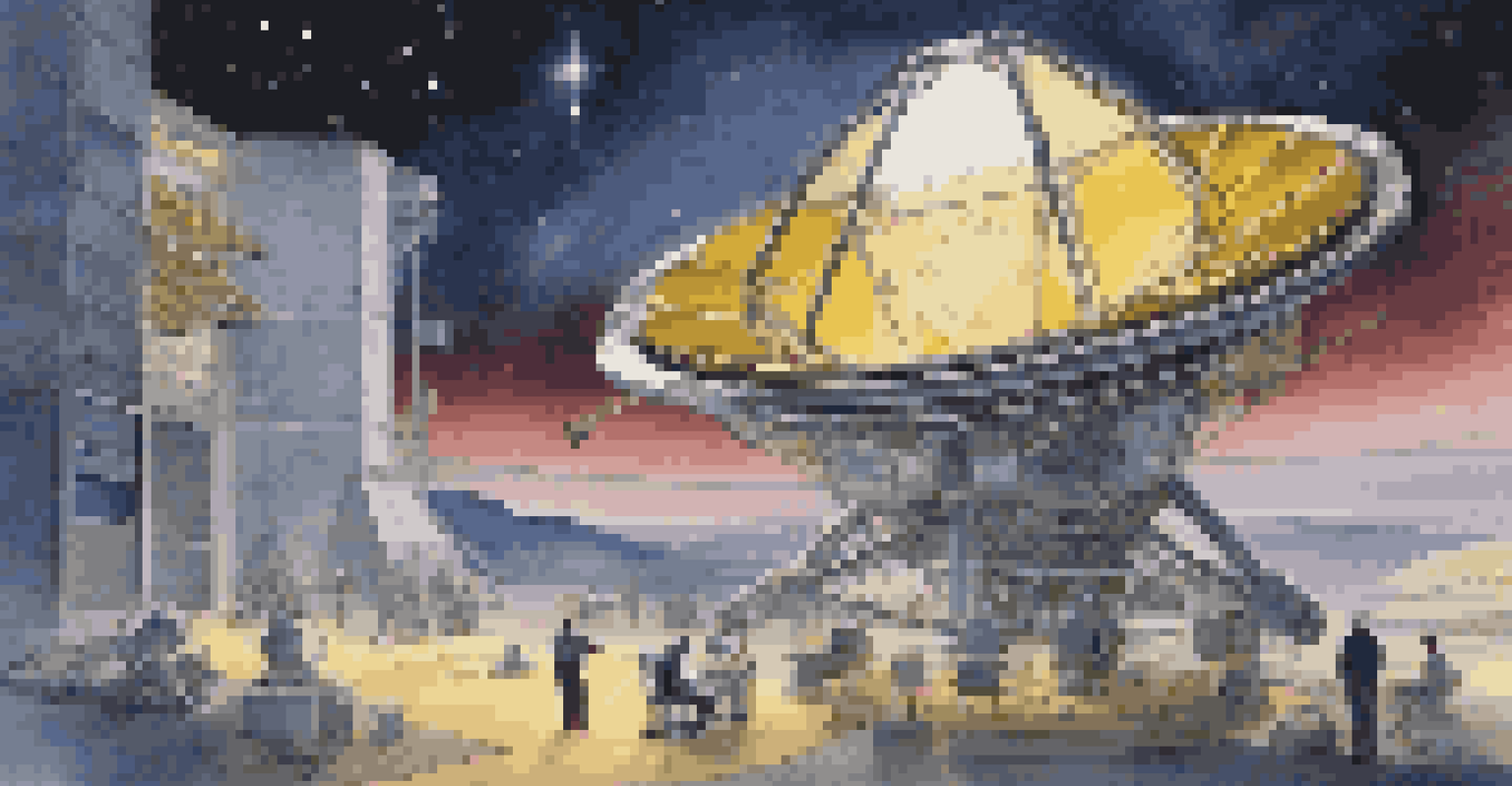The History of Astronomy: Key Discoveries and Figures

Ancient Beginnings: The Birth of Astronomy
Astronomy's roots trace back to ancient civilizations like the Babylonians and Egyptians, who observed the night sky for both practical and spiritual purposes. These early astronomers tracked celestial movements to create calendars, guiding agricultural practices and religious rituals. Their meticulous observations laid the groundwork for future astronomical studies.
The important thing is not to stop questioning. Curiosity has its own reason for existence.
The Greeks advanced these ideas, introducing the concept of a geocentric universe, where Earth was believed to be at the center of the cosmos. Figures like Ptolemy compiled extensive star catalogs and geocentric models, influencing astronomy for centuries. This period marked a significant shift, as observations began to be systematically recorded and analyzed.
However, the Greeks' reliance on philosophical reasoning rather than empirical evidence would later be challenged. This tension between observation and theory set the stage for the revolutionary discoveries that were to come in the following centuries, as humanity's curiosity about the universe continued to grow.
The Renaissance: A Shift to a Heliocentric Model
The Renaissance sparked a pivotal change in astronomy, marked by the shift from a geocentric to a heliocentric model. Nicolaus Copernicus challenged long-held beliefs by proposing that the Sun, rather than the Earth, sits at the center of our solar system. This groundbreaking idea encouraged others to question established norms and explore new possibilities.

Following Copernicus, Johannes Kepler refined the heliocentric model with his laws of planetary motion. He demonstrated that planets move in elliptical orbits, rather than perfect circles, fundamentally changing our understanding of celestial mechanics. Kepler's work was instrumental in bridging the gap between observation and mathematical theory.
Astronomy's Ancient Foundations
Early civilizations like the Babylonians and Egyptians laid the groundwork for astronomy through their celestial observations for practical and spiritual purposes.
Galileo Galilei's advancements in telescope technology further propelled astronomy into a new era. His discoveries, including the moons of Jupiter and the phases of Venus, provided tangible evidence supporting the heliocentric theory. This period was not just about new ideas; it was a revolution in how humanity perceived its place in the universe.
Newton and the Laws of Motion: A New Understanding
The late 17th century saw Isaac Newton emerge as a towering figure in astronomy and physics. His formulation of the laws of motion and universal gravitation provided a coherent framework for understanding the forces governing celestial bodies. Newton's work not only explained the movements of planets but also laid the groundwork for modern physics.
Astronomy compels the soul to look upward and leads us from this world to another.
By publishing 'Principia Mathematica,' Newton demonstrated that the same laws governing the motion of objects on Earth also apply to celestial bodies. This realization unified the terrestrial and celestial realms, transforming astronomy into a rigorous scientific discipline. Newton's laws allowed astronomers to predict the positions of planets and comets with remarkable accuracy.
Moreover, Newton's influence extended beyond astronomy, reshaping scientific inquiry itself. His emphasis on observation, experimentation, and mathematical proof became foundational principles for future scientists. The combination of his insights and earlier discoveries created a robust framework for understanding the universe.
The 19th Century: Expanding the Universe's Boundaries
The 19th century was a time of discovery that expanded our understanding of the universe's vastness. Advances in telescope technology, particularly with the introduction of larger and more powerful instruments, allowed astronomers to observe distant stars and galaxies. This period marked the beginning of modern observational astronomy.
One significant figure from this era was William Herschel, who discovered Uranus and conducted extensive surveys of the night sky. His work helped to identify and catalog numerous celestial objects, expanding the known boundaries of the solar system. Herschel's contributions laid the groundwork for future explorations of our galaxy.
The Heliocentric Revolution
The Renaissance marked a significant shift in astronomy as Copernicus and others challenged geocentric beliefs, leading to a new understanding of our solar system.
Additionally, the development of spectroscopy in the 19th century enabled astronomers to analyze the composition of stars and their light. This technique provided insights into stellar evolution and the chemical makeup of celestial bodies, enriching our understanding of the universe. The 19th century truly set the stage for the astronomical discoveries that would follow.
The 20th Century: The Dawn of Modern Astronomy
The 20th century brought unprecedented advancements in astronomy, driven by innovative technologies such as radio telescopes and space exploration. The launch of satellites and space probes allowed scientists to gather data from beyond Earth's atmosphere, revolutionizing our understanding of the cosmos. This era marked a shift from terrestrial observations to a broader exploration of the universe.
Key figures like Edwin Hubble emerged during this time, whose observations led to the realization that the universe is expanding. Hubble's work not only provided evidence for the Big Bang theory but also established the field of extragalactic astronomy. His discoveries fundamentally changed our understanding of the universe's structure and evolution.
Moreover, the latter half of the century saw the advent of modern cosmology, with theories about dark matter and dark energy emerging. Researchers began to explore questions about the universe's origin, fate, and the nature of its components. The 20th century was a remarkable period of discovery, setting the stage for a deeper understanding of the cosmos.
The Role of Women in Astronomy: Breaking Barriers
Throughout history, women have played crucial yet often overlooked roles in the field of astronomy. Figures like Caroline Herschel and Annie Jump Cannon made significant contributions, often while facing societal barriers. Caroline discovered several comets and became the first woman to hold a government position as an astronomer, while Cannon developed the Harvard Classification Scheme for stars.
Despite their achievements, women in astronomy frequently struggled for recognition and equal opportunities. It wasn't until the mid-20th century that initiatives began to encourage women to pursue careers in science more broadly, including astronomy. Their stories highlight the importance of diversity and representation in scientific fields.
Women Breaking Barriers in Astronomy
Women have made crucial contributions to astronomy, often overcoming societal barriers, and their achievements are increasingly recognized today.
Today, we celebrate the achievements of women like Vera Rubin, whose work on galaxy rotation rates provided evidence for dark matter. As barriers continue to be broken, the contributions of women in astronomy are increasingly acknowledged, enriching our understanding of the universe and inspiring future generations.
The Future of Astronomy: Exploring the Unknown
As we move into the future, astronomy stands on the brink of exciting new discoveries. With advancements in technology, such as space telescopes like the James Webb Space Telescope, we are poised to explore the universe in unprecedented detail. This next generation of telescopes will allow us to observe distant galaxies, exoplanets, and the early universe.
Moreover, the field of astronomy is becoming increasingly interdisciplinary, merging with fields like physics, computer science, and biology. This convergence is leading to innovative approaches in areas such as astrobiology, where scientists explore the potential for life beyond Earth. The quest to understand our universe is more collaborative than ever.

As we look forward to the future of astronomy, we can't help but feel a sense of wonder and curiosity. Each new discovery brings us closer to answering fundamental questions about our existence and the nature of the universe. The journey of exploration continues, inviting us all to look up at the stars and ponder what lies beyond.